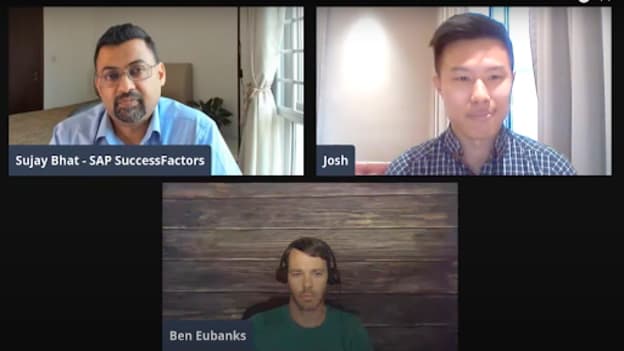Masterclass Session: How to create a Business Case for HR transformation?

Human capital is the core asset of any organisation and it is imperative that we recognise this. Anything that has to do with HR change, cultural change, talent transformation, even employee experience transformation requires investments. But every organisation only has a finite set of resources and various internal departments are competing for them. This is why when HR wants to drive a change agenda, they need to make a value case or a case for change.
In a recent masterclass session hosted by People Matters and SAP SuccessFactors, Ben Eubanks, Chief Research Officer, Lighthouse & Advisory; Founder, HRTech Awards; Podcast Host, We’re only Human; Founder, Upstart HR; Co-Founder, HRevolution; and Sujay Bhat, HR Technology Strategy Officer, SAP SuccessFactors come together to give insights on the tried-and-true methods that can be employed for HR transformation business case building. Here are some excerpts:
Digital transformation is the new normal:
During the pre-COVID phase, organisations used to make a lot of assumptions about the talent and resources they had, they were also habituated to seeing and monitoring their people. With the coming of covid and the post-covid phase as well as the vaccine economy, there was an increase in the velocity of digital conversation. Employees are remote, virtual, flexible in the way they work which makes employee engagement and connection important areas of consideration. Employee experience in the flow of work is critical and needs to be integrated, they should have easier access to data and information so that they are able to get work done in a remote and virtual working ecosystem. The focus on the digital aspect has to go hand-in-hand with the people agenda.
Sujay shares, “Technology becomes a critical backbone in the New Ways of Working.”
Business transformation with the right data:
Bhat stresses on the fact that business transformation starts with people, culture and employee experience transformation, that are simply anchored by the HR department. People Transformation impacts policy, process, technology and competency and all of these aspects are interdependent and connected. Alignment to the organizational goals, acquiring stakeholder buy-in, establishing a compelling reason for People Transformation will all be critical for acquiring investment budgets. Hence, this is not about HR Transformation but People Transformation to fuel Business Transformation, anchored by the HR Department.
To this, Eubanks adds the need to talk to leadership to find the leverage points, where they would be willing to support and invest. Data must be on hand as it is a critical element to having an impact and building a case. Data and people are not separate and companies which are more data oriented tend to prioritise consultative skills to interact with business leaders and understand their needs, they also become a strategic partner that leads and is proactive.
“When we get the data right, we can serve people in a better way because we understand what they need and how to do it in the right way rather than making educated guesses. We know exactly where the target is and hit it right every time,” emphasises Ben Eubanks.
The 5W approach to business transformation:
Every plan, especially a business transformation plan has key areas of concern which has been broken down by Bhat as 5W’s or 5 set of questions, all of which are deeply rooted in overall business strategy:
- Why do we have to do this? In order to find an answer to this question, it is important to understand and articulate the drivers for change, what are the current baselines and how will these be improved and the impact on stakeholders. have a baseline, this very baseline also helps articulate your motivations to the stakeholders.
- What do you need to do based on where your business is going? This is a context-specific question and varies from organisation to organisation. The implications could be on policy, process, technology or even skills & competencies.
- When do we start this? When organisations have a global footprint, where do they start? Do they align it to a specific business, HR, Rewards, or compensation cycles?
- Where do we start? Geo Vs Business or LOB Vs Functional areas etc. Do we start it with a complex country roll out or the simplest one? Do I start with talent acquisition or talent development based on needs of the business? It is important we choose a site where the possibility of a quick win is higher for it provides confidence and shows value.
- Who are my internal stakeholders, my internal sponsors? Who are the executives sponsoring this project? Who do we select internally in our teams to be part of this futuristic project? Do we acquire or build these competencies? Who do we partner with? Who are neutral consultants who have done this before who can guide us?
Eubanks adds that it is critical to have a coalition which offers support in making this happen, which believes in the transformation agenda. One has to take account of scope creep and be very deliberate about where change can start. The process can be broken into phases, where each phase can offer feedback as we move to the next phase.
Key learnings to keep in mind to structure the business case:
Firstly, HR Tech is critical because policies depend on execution and technology is necessary to execute with scale. Secondly, focus should be on changing the outcomes from an experience standpoint or from a key KPI or metrics standpoint. Thirdly, one must not get into feature functionality quicksand. There needs to be clarity about what the organisation needs and culture while making a case for transformation. Finally, there must be reliance on current baselines, on peer benchmarking, expected future gains via efficiency, effectiveness, talent outcomes or even end user experience transformation in the case for transformation. The gains have to be taken over a period of Time and included in the overall Total Cost of Ownership calculations.
A final takeaway is that investments need to have a return for HR whether it’s for technology, process or people. The requirement analysis document has to be watertight; there must be clarity and data on the needs, time, effort, money needed, new skill sets to be acquired and a detailed ROI on a long-term basis for technology implementation. And always a space to be made for uncertainties, in light of the Covid pandemic.
Watch the full video here.














